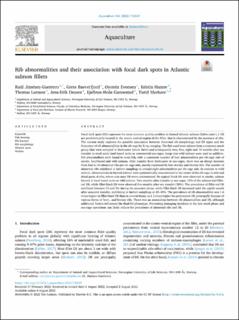| dc.description.abstract | Focal dark spots (DS) represent the most common quality problem in farmed Atlantic salmon (Salmo salar L.). DS are predominantly located in the cranio-ventral region of the fillet, that is characterized by the presence of ribs. The current study explores the possible association between abnormal rib morphology and DS types and the frequency of rib abnormalities in the rib cage by X-ray imaging. The fish used were salmon from a common smolt group that were sampled in freshwater (smolt farm) and subsequently two, five, eight and 14 months after sea transfer to small-scale land-based tanks or commercial sea-cages. Large size wild salmon were used as additive. Rib abnormalities were found in most fish, with a consistent number of four abnormalities per rib cage side of smolts, land-based and wild salmon. After transfer from freshwater to sea-cages, there was an abrupt increase from four to 10 abnormal ribs per rib cage side, mainly explained by low-density and shorter ribs. The number of abnormal ribs stabilized in further samplings at around eight abnormalities per rib cage side. In contrast to wild salmon, abnormalities in farmed salmon were symmetrically concentrated in the center of the rib cage in mid and distal parts of ribs, where also most DS were concentrated. No typical black DS were observed in smolts, salmon farmed in land-based tanks or wild salmon. Two months after transfer to sea-cages, 15% of the salmon had fillet-red DS, while fillet-black DS were observed five months after sea transfer (30%). The prevalence of fillet-red DS oscillated between 15 and 3% during the seawater phase, while fillet-black DS increased until the eighth month after seawater transfer, stabilizing in further samplings at 43–45%. The prevalence of rib abnormalities was 1.6 times higher in fillet-black DS than in control tissue, and 2 times higher for peritoneum DS, principally because of various forms of bent-, and broken ribs. There was an association between rib abnormalities and DS, although additional factors influenced the final DS phenotype. Preventing damaging incidents in the late smolt phase and sea-cage operations can likely reduce the prevalence of abnormal ribs and DS. | en_US |
